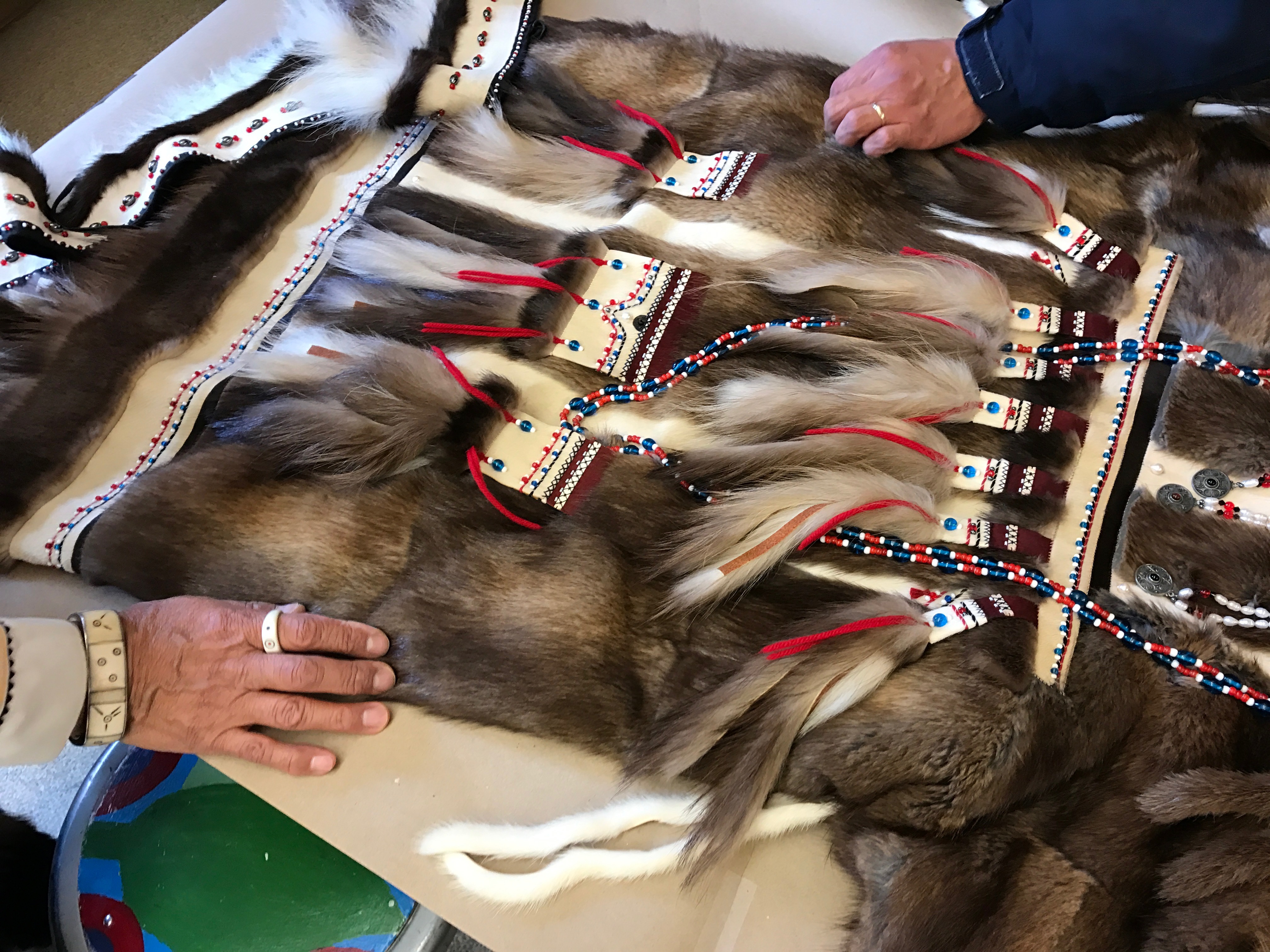Yup’ik culture bearer shares the art of fur at Cama-i

BETHEL – In a high school art room, where walls are plastered both with rules on bathroom breaks and posters on theories of design, an ancient art is revealed.
Exquisitely detailed parkas of muskrat, squirrel and rabbit are displayed on tables. There are beaded headdresses and detailed belts, fur hats and pieced vests, a men’s shoulder bag and a Yup’ik doll. All of it is there to show how for generations Yup’ik people combined function and beauty, and how they still do.
“Without me even talking about them, they speak volumes,” said Chuna McIntyre, a Yup’ik artist, dancer, and culture bearer who made the garments.
McIntyre was showing some of his favorite pieces during a Saturday workshop on traditional Yup’ik regalia at this year’s Cama-i Dance Festival in Bethel.

He grew up in the Southwest Alaska village of Eek near the Bering Sea and splits his time now between California, Hawaii and Alaska. He travels the world as a Yup’ik cultural ambassador but also adds modern twists and references to his Scottish grandfather, writing his name “Mc Intyre” as was the old way. He incorporated Celtic beads into his belt, made of seal skin and wolf.
“What the wolf is doing is continually giving me strength,” McIntyre said.
Everywhere he goes, he brings pictures of his grandmother, mother and other treasured loved ones who have died, to show them the world he is exploring and learning from as he teaches.
“I’ve been to Australia, New Zealand, Korea, Siberia and the list goes on,” McIntyre said. “To tell them that yes, we are here, we are still viable and we remember.”
A black-and-white photo he took of his grandmother at age 85 wearing a fur hood called a yuraryaraq, Yup’ik for “one you don on,” was prominent at the workshop. Her English name was Minnie Carter, and in Yup’ik she was Augilnguq or “bloodless one,” born in an ancient place near the village of Quinhagak.
“She was my No. 1 teacher. She was the one who told us about our ancient designs and colors,” he said. He pointed to another picture, of his great aunt, a picture that gives a sense of presence and power.
He still sticks to white, red and blue, colors found in minerals along Yukon-Kuskokwim Delta shoreline cliffs.
He made the parkas on display in the classroom, a muskrat one for his younger sister that took him eight months, a squirrel one for his sister-in-law that took maybe half that, a white rabbit one with an ancient-style rounded hem, or qaggluni. He dated the squirrel parka on the inside under the cloth lining: 1993. It still looks new. It also looks warm; crucial in a region where winter still sees temperatures of 30 below even without the biting winds.
Harry Alexie of Kwethluk looked over the squirrel parka with his wife, Sharon. They started trapping squirrel with their two children about five years ago. They dry and eat the meat and sell or use the skins. Some of the first were turned into a parka for Sharon by a skin sewer and now she is making her first fur parka out of muskrat.
Alexie admired how McIntyre used the whole skin of the squirrel, the darker back and the lighter belly alike.
That contrast, or miluluteng, is part of the design, McIntyre told him. Could McIntyre make a parka for his wife? Alexie asked in Yup’ik. What would it cost?
“I’d have to think about it,” McIntyre answered. “Because it takes so much out of me.”
Not many people know how to make fur parkas anymore. A class just wrapped up on the Kuskokwim campus of the University of Alaska Fairbanks that aimed to revitalize the skill. Some of the students showed their creations on the main stage at Cama-i later Saturday.
“It takes time and the students are doing their very best,” said McIntyre, who shared some of his knowledge with that class when it began. His parkas were modeled during the parka parade too.
Yup’ik people create these special pieces, still worn in dances and for celebrations, with care, deliberation “and a certain aesthetic for beauty,” he said.
Making every piece as beautiful as it can be honors the animals that gave up their lives, animals he is so grateful for, as well as his ancestors, he said.
“Because when we decorate ourselves for the dancing ceremonies it is not just for you or me,” McIntyre said.
The ancestors, he said, are watching too.